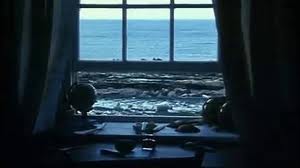Being a writer – and a Reader in Residence – has its perks, and recently I experienced them when I was invited to Orkney to be part of the Orkney Book Festval, the brainchild of the sterling people who make up the George Mackay Brown Fellowship.
A major part of the festival was the celebration of the life and works of Orkney born film-maker and poet, Margaret Tait.

Margaret (1918 – 1999) left Orkney to go to boarding school in Edinburgh, then trained as a doctor and served in the medical corps during the war, before deciding to study film at the Centro Sperimentale di Cinematografia in Rome in the early 1950s. Always innovative and experimental in her early short films, which she liked to think of as ‘film poems’, she made her first and only feature film, the iconic Blue, Black, Permanent, at the age of 71.
Not only was I able to view Blue, Black, Permanent in an atmospheric converted church in Stromness with an Orcadian audience, but also present was the film’s star, poet and actress, Gerda Stevenson.

Sadly, I’ve been unable to find any still images online that do credit to the amazing use of colour, water and light in Blue, Black, Permanent. Some of the shots have stayed with me, such as the steady train of the camera on a tiny cliff-top flower being battered by an unrelenting wind. Or the iconic image of a rain-lashed Greta standing alone on steep stone Edinburgh steps during a torrential rainstorm. While in the Orkney sequences in particular the sounds of the sea and the wind made the film a truly sensory experience.
It’s not a story for those who like their movies heavily plot and action driven. Or for that matter, straightforwardly sequential. Indeed, it’s more akin to an Alice Munro short story; a complex tale told through quietly observed exchanges and challenging time-shifts, the artist’s eye selecting the telling detail, a seemingly simple scene or image reverberating in the memory for days afterwards.

It’s also, in the best tradition of art-house films, open to individual interpretation. As a young woman, Greta struggles between her longing to be a good mother at the centre of her family, and her overpowering, almost elemental urge to be an artist. Add to this a strong mother-daughter theme with all the complexities of a woman’s desire to both deny, and even destroy, the mother, as well as the need to integrate her and all she represents.
It’s a powerful and, in Scottish and feminist terms at the very least, an important film. So I was saddened, though perhaps not surprised, when Gerda, in conversation with Dr Sarah Neely of Stirling University’s Film Department after the viewing, recounted how negatively the film had been received by Scottish writers and artists, including women, when it was premiered at the Edinburgh Festival in 1992.
As soon as I’d finished watching Blue, Black, Permanent, I wanted to see – to experience – it again. I don’t know when there will next be an opportunity to view it on a big screen, which I suspect is really needed to fully do it justice, but you can find it on You Tube here. http://www.youtube.com/watch?v=wbY6ssQTTgE
Almost as amazing as the film was Margaret Tait’s life-long determination to do her art exactly as she wanted to. She made this first full-length film at an age when most people are content to put their feet up and head off on a Saga holiday.
There will be more of the amazing Margaret Tait and GWL’s connections with her in a future blog…
Magi
If you’d like to read more about this interesting artist, you can borrow or buy ‘Margaret Tait: Poems, Stories and Writings‘ edited with an introduction by Sarah Neely, and a foreword by Ali Smith, at Glasgow Women’s Library.

Comments are closed.